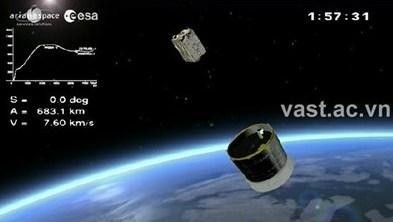Nearly two hours after the Vega rocket blasted off from the Kourou space centre in French Guiana, VNREDSat-1 was separated from the launcher and placed into orbit. At 14h30 on the same day, VNREDSat-1 transmitted the first signals back to Earth.
On this occasion, Nhan Dan sat down for an interview with Professor Nguyen Khoa Son, Director of the Space Science and Technology Programme of the Vietnamese Academy of Science and Technology (VAST).
Q: Professor Son, could you please tell us how you felt when VNREDSat-1 was successfully placed in orbit?
A: To be honest, I myself and the VAST staff, as well as the Vietnamese people, were very happy and excited about the successful launch of VNREDSat-1.
The manufacturing of the satellite was completed in February and transported from Toulouse to the Kourou space port, since that time we have been on an emotional roller coaster with mixed feelings, both worry and excitement.
Initially, Arianespace was scheduled to launch the VNREDSat-1 on April 19, but the launch was pushed back until May 4 and then delayed again until May 7 when the satellite was finally put into orbit. The launch date is dependent on a number of critically important factors including the safety of the European Space Agency’s Proba-V satellite, Estonia’s first satellite ESTCube-1, quality of the launcher, and weather conditions. Since this is only the second mission of the Vega launcher, Arianespace wanted to take every necessary precaution to make sure that conditions were optimal, that’s why the launch date was postponed twice.
Q: Can you please tell us more about the VNREDSat-1 satellite?
A: VNREDSat-1 is Vietnam’s first Earth observation satellite. It was designed and manufactured by Astrium starting in early 2011 and it took until February 2013 to complete. After an array of rigorous tests, VNREDSat-1 was certified eligible for take-off in early March.
The satellite measures 600 mm x 570 mm x 500 mm and weighs around 120 kilogrammes. It is an optical satellite capable of capturing images at 2.5 metres in panchromatic mode and 10 metres in multi-spectral mode (four bands) with a 17.5 kilometre swath and will orbit at an altitude of 665 kilometres in a sun synchronous orbit. Its lifespan is roughly five years.
The history of space science and technology has seen numerous failures during the launch of satellites and manned spacecraft and they are hardly unavoidable. Our most worrisome concern was that we could encounter some faults during the launch.
However, it still remains to be seen how VNREDSat-1 will operate after it has been placed in orbit. We anticipated that the satellite’s imaging function might not work properly so it has been insured for three months from the launch date. When the satellite is stable in its orbit, it will then be handed over to Vietnam.
Q: As you said control of the satellite will be handed over to Vietnam only after it has been stable in orbit for three months. So what is the most important thing that we should do now?
A: Unlike communications satellites VINASAT-1 and VINASAT-2 which are used for commercial purposes, the main function of VNREDSat-1 is capturing images of the Earth for scientific research. Having a stock of images from VNREDSat-1 is a significant breakthrough in the implementation of the strategy on space technology research and application until 2020 because in the past we had to buy images from foreign providers at a huge cost and it took months before images were delivered to us.
Once we have VNREDSat-1, we can take the initiative and capture high-resolution images for socio-economic development purposes, particularly surveying forest resources and arable land, prospecting for minerals, monitoring disasters and tackling climate change.
Therefore, the most important thing is to make full use of the stock of satellite images. This requires the Operating Centre under the VAST, the Centre for Satellite Signal Reception and Transmission at the Hoa Lac High-tech Park and the Satellite Image Reception Station under the Ministry of Natural Resources and Environment to work closely together.
In 2011 and 2012, we sent 15 engineers to France for training about satellite operation but we still lack in qualified personnel. The VAST is working with relevant agencies to recruit hundreds of engineers until 2016 and send them to Japan, France and Belgium so that they can learn about the space technology.
We aim not only to make full use of satellite images from VNREDSat-1 but also to master the miniaturised satellite technology in 2020 when the Vietnam Space Centre in Hoa Lac is put into operation.
Thank you very much.
















